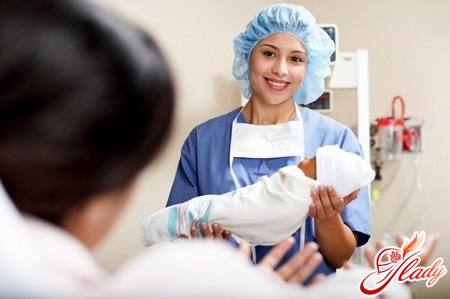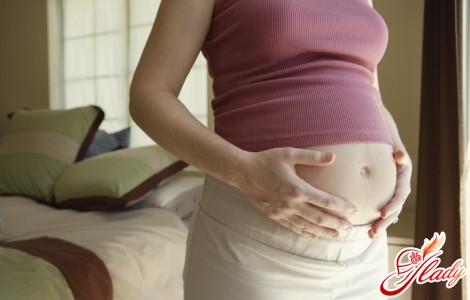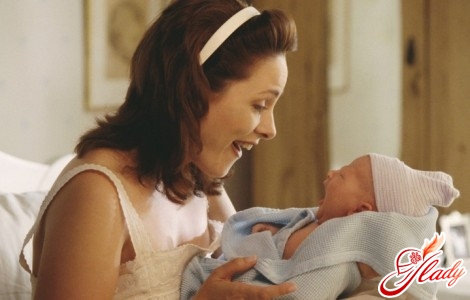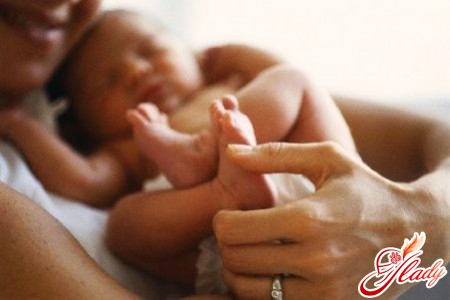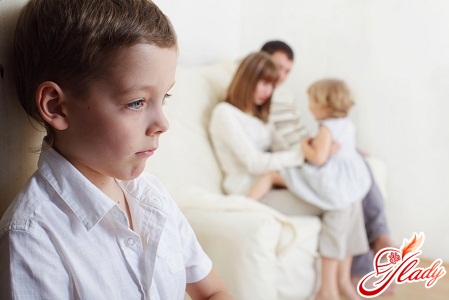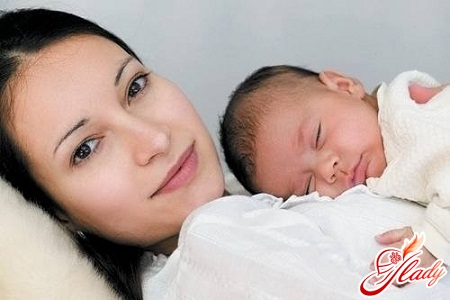 The first 6-8 weeks after the birth of the child -This is a period of physical and emotional adjustment. The work of 9 long months is over, you have seen your wonderful baby, a feeling of spiritual uplift and blissful lightness has replaced the heaviness of the last days. But soon the euphoria passes, and you feel tired and slightly weak. You need a good rest. After childbirth, your body undergoes rapid physical and hormonal changes. These changes are normal, but can be accompanied by fatigue, which undermines your well-being and confidence in the ability to cope with a newborn and changes in lifestyle. Your family is adapting to the appearance of a baby in the house, the responsibilities of each family member change, all efforts are aimed at meeting his needs. Help from close relatives or friends during this period is especially necessary. The relationships in each family are unique and one of a kind. Some families find a comfortable balance within a few weeks after the birth of a child, others need months and a longer time. The family experience is influenced by many factors, including the personality of the child, medical complications of the mother or child, the amount of care provided, economic resources, experience in feeding and caring for the child, and the situation: whether the parents are self-reliant or can rely on help from loved ones, single motherhood, mixed family structure, and, finally, the adaptability and flexibility of the parents. Understanding the main issues associated with the postpartum period can help you assess the burden in the future and plan for the care you will need.
The first 6-8 weeks after the birth of the child -This is a period of physical and emotional adjustment. The work of 9 long months is over, you have seen your wonderful baby, a feeling of spiritual uplift and blissful lightness has replaced the heaviness of the last days. But soon the euphoria passes, and you feel tired and slightly weak. You need a good rest. After childbirth, your body undergoes rapid physical and hormonal changes. These changes are normal, but can be accompanied by fatigue, which undermines your well-being and confidence in the ability to cope with a newborn and changes in lifestyle. Your family is adapting to the appearance of a baby in the house, the responsibilities of each family member change, all efforts are aimed at meeting his needs. Help from close relatives or friends during this period is especially necessary. The relationships in each family are unique and one of a kind. Some families find a comfortable balance within a few weeks after the birth of a child, others need months and a longer time. The family experience is influenced by many factors, including the personality of the child, medical complications of the mother or child, the amount of care provided, economic resources, experience in feeding and caring for the child, and the situation: whether the parents are self-reliant or can rely on help from loved ones, single motherhood, mixed family structure, and, finally, the adaptability and flexibility of the parents. Understanding the main issues associated with the postpartum period can help you assess the burden in the future and plan for the care you will need.
Physiological features
The beginning of the postpartum period is considered to be the momentexpulsion, from this moment on, changes occur in the female body, which generally end only after 8 weeks. These changes are varied, occur at different speeds. You can feel them, not notice them at all - but one way or another, after 2 months, the functioning of your body will differ little from what it was before pregnancy. Some manifestations of the ongoing restructuring may bother you, although they are normal. In the first 2 hours after childbirth, the uterus contracts strongly, bleeding from its gaping vessels stops - they are closed with blood clots, thrombi. If there is a deviation from the normal course of the early postpartum period, bleeding may not only not stop, but also intensify. Therefore, both the doctor and the midwife monitor the woman in labor during these first hours. Later, the uterus increasingly decreases in size, its walls thicken from 0.5 to 3 cm, the lumen of the cervix narrows. Immediately after childbirth, a hand can be inserted into the cervix through the internal os, a day later - 2 fingers, on the 3rd day only one can pass. By the 10th day, the cervical canal has already formed, but the external os still allows the tip of a finger. On the 3rd week, the external os closes. The process of restoration (involution) of the genitals proceeds differently - its intensity depends on many factors: individual characteristics of the body, nutrition, resistance of the body, lifestyle, etc. There may be complaints of minor and intermittent pain in the area of the external genitalia and perineum. After a few days, this pain should disappear. A day or two after childbirth, soreness in the mammary glands occurs; this is a sign that the process of milk formation has become active in the glands. When a young mother feeds her baby, she may feel pain in the lower abdomen - this pain is minor, cramping in nature; the pain indicates that the uterus is contracting. In order to influence the process of uterine contraction and make it more intense, nature uses a reflex mechanism - the baby irritates the nerve endings embedded in the mother's nipples, and the mother's body responds to this irritation by contracting the uterus. The doctor regularly monitors the condition of the woman in labor: measures blood pressure, counts the pulse, checks breathing. Blood pressure, pulse, and respiratory rate in a woman in the postpartum period should be the same as they were before pregnancy. If there are no complications, body temperature is also within normal limits. When the lactation process is activated and pain in the mammary glands appears, body temperature will rise slightly, but it does not last long. Your physical condition during this period depends on what kind of birth you had (difficult or easy) and on a number of individual factors. In addition to the restoration of the genitals, changes occur in other systems:
- Mammary glands:swell, become painful, under the influence of the lactogenic hormone of the anterior pituitary gland, the process of lactation begins - milk formation; milk appears within 1-2 days after birth.
- Skin: gradually increases the tone of the abdominal muscles; completely it is restored approximately in one and a half month after sorts.
- Urinary system: the tone of the bladder has been lowered for some time after delivery, so that the urge to urinate is less frequent than before; during several days after delivery can be noted soreness with urination, as urine irritates the mucous membrane of the external genitalia, the integrity of which is disturbed during childbirth.
- Intestine: As a result of a sedentary lifestyle at the first time after childbirth, as a result of a decrease in the tone of the muscles of the abdominal press, the tendency to constipation can be clearly indicated.
Possible worries
Uterine discharge (lochia) BloodyThe discharge may continue for 3-6 weeks, its composition is complex: blood clots, mucous discharge (lymph, serum), remnants of uterine tissue elements (decidual membranes). There is no reason to worry. During the first three days after childbirth, lochia is sometimes as abundant (and sometimes stronger) as during menstruation. And although the bloody discharge seems very abundant, its total volume does not exceed 500 ml, starting from the first moment until it completely stops. Sudden bloody discharge from the vagina when getting out of bed during the first few days is a natural phenomenon and is not a reason for concern. Due to the fact that the discharge immediately after childbirth consists mainly of blood and a small amount of clots, during the first 2-3 days it is red, and then gradually turns into a serous color, and within 1-2 weeks it becomes light yellow. In order to comply with the rules of personal hygiene, you should use sanitary pads, and the use of tampons is not recommended. You probably worked harder than most boxers in the ring when you were giving birth, so it's not surprising that after the intense contractions and grueling pushes of labor, you feel like a boxer after a couple of rounds in the ring. Many women report that labor was long and/or difficult. And the following signs are nothing special after childbirth:
- blue circles under the eyes and reddened eyeballs;
- bruises: from small spots on the cheeks to large bruises and dark blue spots on the face and on the upper part of the chest;
- pain in places of incisions (perineal incisions, caesarean section), painful sensations in places of suturing;
- difficulties with deep breathing due to fatigue.
We have already talked about ways to restore the uterusearlier (massage, oxytocin, etc.). If necessary, you will receive medical care in the postpartum department of the hospital, but if signs of uterine bleeding reappear after discharge, you must urgently see a doctor, preferably in the same hospital where the birth took place. Well-being After hard work, and you can imagine childbirth in this way, your well-being leaves much to be desired. We will talk about physical recovery later, and you can try to cope with some unpleasant moments in the near future:
- get rid of blue circles under the eyes and reddened eyeballs will help cold 10-minute compresses;
- pain and hypersensitivity in the coccyx may be caused by damage to the pelvic muscles, massage and heat will help ease the pain;
- painful manifestations in the chest area can be reduced by warm compresses, if there are no contraindications, you can take a hot bath or douche.
Pain in the perineum Pain in the perineum at anynatural childbirth with tears or cuts. Like any stitched wound, tears or cuts require time to heal (7-10 days). During this period, it is especially important to follow the rules of hygiene:
- watch for cleanliness of the pads, change them every 4-6 hours; make sure that they do not move forward or backward;
- remove the pads by moving from front to back to prevent the entry of microorganisms from the anus to the vestibule of the uterus;
- rinse with warm water (or antiseptic liquid, if prescribed by the doctor) perineal area every time with a natural need;
- try not to touch the hands of the perineum until the gaps (cuts) heal;
- the crotch carefully wipe with a dry napkin (you can use paper), remembering at the same time that you need to wipe the movement from front to back.
You can relieve the pain with warmcompresses, you may be prescribed warming with special lamps, local anesthesia with aerosols, creams or irrigation. Cold compresses give good results, as well as exercises to improve blood circulation. In the postpartum period, you should avoid prolonged sitting or standing to avoid tension in the perineal tissues. It is better to sit on a pillow (an inflatable one is possible), and while sitting, squeeze your buttocks.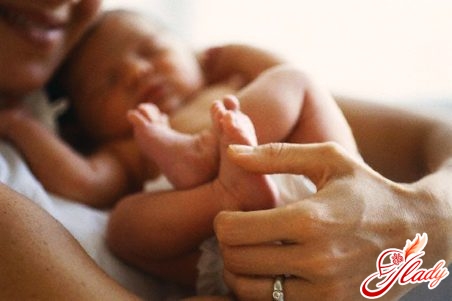 Difficulty urinating Difficultyurination is quite normal during the first 24 hours after childbirth. Some women do not feel any pressure in the bladder at all, while others feel the urge but cannot empty the bladder. Some women urinate but feel pain and burning. There are many reasons for bladder dysfunction in the postpartum period:
Difficulty urinating Difficultyurination is quite normal during the first 24 hours after childbirth. Some women do not feel any pressure in the bladder at all, while others feel the urge but cannot empty the bladder. Some women urinate but feel pain and burning. There are many reasons for bladder dysfunction in the postpartum period:
- the increase in the volume of the bladder is explained by the fact that after the birth the space for its expansion sharply increases; for this reason there is no need for frequent emptying;
- in the process of delivery, the bladder can be traumatized during the passage of the fetus. As a result, even a filled bladder may not signal the need for urinary diversion;
- anesthetics can reduce the sensitivity of the uterus to signals coming from the bladder;
- pain in the perineum can be the cause of spasmodic contraction of the urethra, which makes it difficult to remove urine. Swelling (swelling) of the perineum can also have an effect on urination;
- The bladder can be controlled by certainpsychological factors, for example, fear of pain, appearing with an empty bladder, unpleasant sensations when urinating, difficulties in using the boat, the need to use outside help in the toilet;
- increased sensitivity of joints applied toincision or rupture, may be the cause of pain when urinating (in this case, you can recommend standing up with your legs apart, while the urine stream directed downwards will not touch the painful sections of the urethra wall).
Despite the difficulties, it is necessary to emptybladder 6-8 hours after birth to protect the urinary system from possible infection. If you have not been able to empty your bladder on your own within 8 hours after birth, you may be asked to use a catheter. You can help your body by:
- as soon as possible after birth, get out of bed and walk around, it stimulates the work of both the bladder and the intestines;
- if you are too weak to go to the toilet yourself and are forced to use the ship, then ask (if possible) to recover without strangers;
- use the vessel while sitting, not lying down;
- try warming up the perineum with warm compresses or cooling with an ice-warmer, choose the way that stimulates urination.
Another problem may appear in a day- excessive urination. As pregnancy hormones are eliminated from the body after childbirth, urination becomes more frequent and profuse. If after a few days the urine output is still small or difficult, it is quite possible that this is the result of an infection in the urinary system. Inflammation of the bladder is accompanied by a burning sensation in the urethra, frequent and small urination, and a slight increase in temperature. Symptoms of a kidney infection are more pronounced - the temperature may rise sharply (up to 38-40 °), pain in the lumbar region on both sides, usually accompanied by symptoms of inflammation of the bladder. In this case, antibiotic treatment is necessary. After childbirth, many women notice that they have difficulty holding their urine, especially when sneezing, coughing or laughing. This happens if the sphincter muscle of the bladder was overstretched during childbirth. The following exercises help:
- squeeze the vagina and after 10 seconds, relax it; while the muscles of the walls of the vagina are strengthened;
- empty the full bladder not immediately, but gradually, alternating the release of small portions of urine with the compression of the vagina.
With regular exercise, the sphincter muscle will become stronger and will hold urine.
Functioning of the intestine
As a rule, after childbirth, the intestinal tonedecreased, digestion is slow, there is no stool. In order for the intestines to start functioning normally after childbirth, several physiological factors must interact at once: weakened abdominal muscles after childbirth, possible intestinal damage and, finally, psychological factors: unreasonable fear of suture divergence, natural anxiety due to the lack of intimate conditions in the ward, as well as excessive concentration on what needs to be done. Restoring normal bowel function will be helped by following a diet (grain dishes, fresh vegetables and fruits); drinking more fluids (water, juices), physical activity and relieving tension. Sometimes women in labor experience swelling and inflammation of hemorrhoids, in which case chamomile infusion lotions, warm and cold compresses, rectal suppositories, pain-relieving gels and ointments, etc. help.
Troubling signs of the postpartum period
In the first 6 weeks after birth, you may experiencepostpartum complications. The table below describes some symptoms that require contacting a doctor. A short-term increase in temperature (up to 38°C) when milk appears (1-3 days) is not a cause for concern.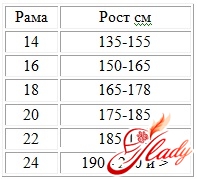
Restoration of motor activity
In the absence of contraindications (difficult labor,cesarean section) no later than 24 hours you need to get out of bed, some doctors allow you to get up after 8-10 hours. The sooner you get up, the sooner independent urination and bowel movements will improve, the function of the genitals will be restored, the abdominal wall will tighten. In addition, this is a good prevention of thromboembolic complications. From the first day in the morning you can do light physical exercises. Do them lying on your back and try not to overexert yourself.
We recommend reading:




